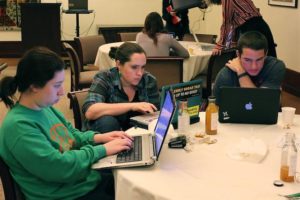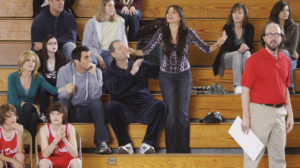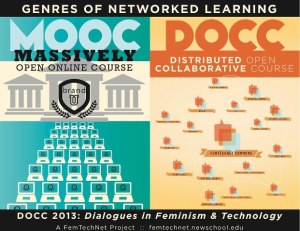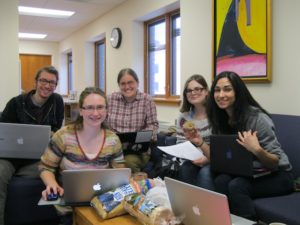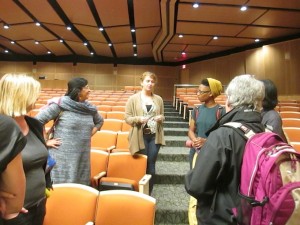UN Global Alliance for Media and Gender, Part One
By Lisa McLaughlin, Miami University of Ohio
Edited by Sharon Irish
December 11, 2013
This “report” has been compiled from a series of posts on the FemTechNet listserv in late November through December 10, 2013. Lisa McLaughlin, Associate Professor, Department of Media, Journalism & Film and Women’s, Gender, & Sexuality Studies Program, at Miami University of Ohio, took the lead for FemTechNet in Fall 2013 in the UN Global Alliance on Media and Gender (GAMG). The Alliance was initiated during a UNESCO [United Nations Educational, Scientific and Cultural Organization] forum in Bangkok from December 2-4, 2013. Together with FemTechNet co-facilitators, Anne Balsamo and Alex Juhasz, Lisa decided to submit the online information necessary to join the Alliance. The full compilation is available as a pdf document here.
What is the UN Global Alliance on Media and Gender (GAMG)? At this point, it is a set of ideas, objectives, and processes. For information on the objectives of the GAMG, a good place to begin is https://www.unesco.org/new/en/communication-and-information/crosscutting-priorities/gender-and-media/global-forum-on-media-and-gender/homepage/.
Lisa also registered to join the debate virtually that took place prior to the forum in Bangkok. Her initial input into the debate was to object to the suggestion that only “truly international organizations” should belong to the Alliance; she argued that there are no “truly international organizations” and that, if we proceed in this way, a number of exclusions–notably at the local/community level–will occur, and the GAMG will be a top-down arrangement.
Lisa wrote: UNESCO is basing the promised declaration and action plan on Section J, women and media, from the 1995 Fourth World Conference on Women in Beijing. Overall–and I know that I am not alone–I think that Section J of the Beijing Platform for Action (BPfA) (https://www.un.org/womenwatch/daw/beijing/platform/media.htm) is thoroughly inadequate for addressing digital media and ICTD [Information and Communication Technologies for Development], especially in a way that addresses gender disparities “on the ground.” Please see this statement from the 2000 Beijing + 5 Media Caucus for a very incisive critique of Section J: https://www.womenaction.org/ungass/caucus/media.html.
Lisa McLaughlin’s statement of November 30, 2013:
It should be recognized that, unlike Security Council resolutions and some conventions, the general UNO pattern suggests that, typically, very little is accomplished in the two years following summits, forums, and conferences, particularly those related to human development-oriented initiatives of UN agencies and organizations. However, if I felt that the activities in the years subsequent to a Global Forum on Media and Gender were inconsequential, I would not be representing FemTechNet for the GAMG.
I am suggesting that, in the two (and more) years following the forum, we need to engage in actions which will keep the enthusiasm generated at the forum going, to keep the issue of media and gender front-and-center as a critical area of concern, to recognize the weaknesses of Section J, and to be prepared to confront issues relevant to gender and the current information and communication environment(s). Answering this future-oriented question requires that we begin by remembering the past. In 1995, after having been a specter in the previous UN Conferences on Women, Section J “women and the media” was added to the list of critical concerns. For purposes of the GAMG, UNESCO has recognized the importance of including Section J at the Beijing Fourth World Conference on Gender:
“This initiative is related to one of UNESCO’s global priorities, namely Priority Gender Equality. It will articulate a systematic follow-up to the Beijing Declaration and Platform for Action, “Women and the Media Diagnosis”, and its strategic objectives:
- Strategic objective J.1: Increase the participation and access of women to expression and decision-making in and through the media and new technologies of communication.
- Strategic objective J.2: Promote a balanced and non-stereotyped portrayal of women in the media. [1]”
But, let’s consider that, after 1995, “women and the media” largely was marginalized, ignored, and forgotten during the various Beijing follow-ups, perhaps in part because of what is described as the “strategic weakness” of Section J in the Beijing + 5 review, Gender and Media Caucus statement at https://www.womenaction.org/ungass/caucus/media.html. The critique that Section J “failed to articulate the structural constraints and impediments that women and other marginal groups face due to commercialization and globalization of media and the concomitant decline of public broadcasting media in societies with democratic and pluralistic traditions” is spot on.
Still, post-Beijing follow-up meetings failed to adequately address Section J, and “gender” certainly was not a priority in the World Summit on the Information Society proceedings (unless, I suppose, it could be tied to internet governance, which became the almost singular issue of concern by the end of the WSIS process).
Within this context of marginalization and forgetting of gender and media, UNESCO’s prioritization and efforts to focus on numerous aspects of gender and media–with what appears to be a more intensive approach to the “digital age” than was the case in Section J in 1995–is very welcomed.
However, I am suggesting that it now is time to go beyond Section J and confront its “strategic weaknesses,” as outlined in the Beijing + 5 Media Caucus Statement (url above).
Among my suggestions: First, although public-private partnerships [PPPs] were in place in 1995, the past two decades have seen an enormous increase in public-private partnerships involving ICTs forged among the private sector, UN agencies, governments, and NGOs. Many of these proceed without any meaningful oversight. At best, we get a handful of “best practices stories” which tell us nothing of the PPPs that have failed and continue to fail to enable and empower the communities targeted for these initiatives, generally because of the failure to encourage community and local input and participation. (These claims follow from empirical, ethnographic and political economic, research). The notion of targeted groups for PPP initiatives must be abandoned in favor of understanding groups and communities composed of persons who are capable of expressing their needs and desires, persons and groups who are capable of innovating. Missing the latter generally is a sign that a corporation is more interested in wrapping themselves in the blue mantle of the UN flag for promotional purposes than in working with marginalized groups. Because private sector funds now fill the void as public funding has decreased, or is non-existent, PPPs seem here to stay. However, not all PPPs are alike, and we should demand that PPPs are oriented to serving human needs above all else (while knowing that, however doctrinal, it by no means is clear that access to ICT is the ultimate way to serve human needs).
Second, Section J is about images and jobs–the usual two sub-areas that have arisen when discussing changing the representation of women since the late 1960s. This is so limited and has tended to avoid both the structural and local aspects of imbalances and inequalities. We don’t need additional great projects of “stereotype-hunting” as a follow-up to the Forum on Media and Gender. This has been done and is useful mostly as a form of consciousness-raising. As UNESCO is aware, many aspects of media and gender need to be identified, analyzed, and confronted.
A final problem is that the various sections of the 1995 Beijing Platform for Action (BPfA) actually overlap but are treated as separate in such a way that literacy largely remains with “education” while many of the more problematic ways of addressing women’s lack of access to IT–notably public-private partnerships and increased privatization of services–are addressed in other sections having to do with employment and the economy. With the GAMG, there are no areas of concern “competing” with “women and the media,” so there is no reason to create divisions among societal areas by sections and bulletin points. Perhaps one of our objectives should be to guarantee that Section J cannot be ignored in the future.
What was “media” has become much, much more – so closely intertwined with our world and its multiple realities and spaces. Does this require a new digital age or network society (or info society) level response to issues of gender and media?
Part Two has a further exchange between Lisa McLaughlin and other FemTechNet participants.

